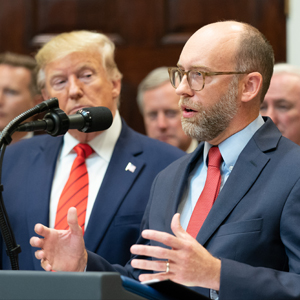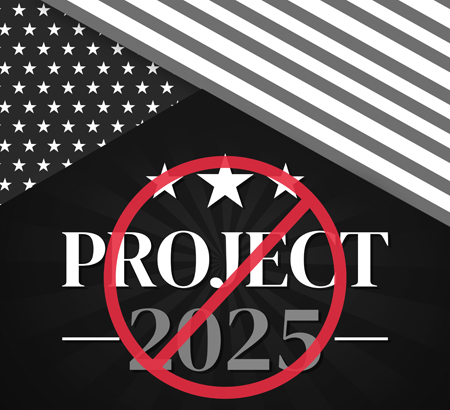Commentary: Project 2025: Why South Asian Americans Should Be Concerned

This overarching right-wing manifesto, besides being a grave threat to American democracy, is also an oblique assault on all marginalized communities. Here are nine ways South Asians in particular could be affected.
[Left] Donald Trump with Russell Vought, his former cabinet member, who is the primary author of Project 2025. Despite Trump’s attempt to distance himself from it, his track record, affiliations, and policy proposals are suggestive of his close alignment with the objectives of this malicious manifesto. Schedule F, a key component of the Project, was signed into an executive order by Trump during his first term as president. (Photo: Shealah Craighead/White House)
How would you feel if the science education in our public schools was informed by Biblical theories? What if a beloved family member could be deported and sent back home solely on technical grounds? Can you imagine a world in which the federal departments of Education and Homeland Security were dismantled?
These are just a few policy recommendations at the heart of Project 2025, a 900+-page political manifesto produced by the Heritage Foundation, an influential conservative think tank that has historically influenced the policies of the Republican Party. The goal of this ambitious manifesto is to transform the political landscape of the nation in favor of a far-right worldview. By advocating for white Christian nationalism, Project 2025 discriminates against minority communities along the lines of race, skin color, religion, gender, and sexuality. A striking aspect of the agenda is its extreme anti-immigrant focus.
At its core, Project 2025 proposes a consolidation of power in the presidency by placing the entire federal bureaucracy—including independent agencies such as the Department of Justice—under the direct control of the president. It threatens to overhaul the federal workforce by firing tens of thousands of government employees and replacing them with political appointees loyal to the president.
“Project 2025 will take away freedoms and rights from every American, will hurt the middle class and working families, and is a threat to our democracy,” cautioned Everett Kelley, President of the American Federation of Government Employees (AFGE), which represents 750,000 federal government workers across the United States and the world.
Broadly speaking, South Asian Americans will be targeted by Project 2025 in numerous ways because of our marginalization on the counts of race, skin color, religion, and immigration status.
The impact of Christian nationalism on South Asian Americans
According to the George Washington Institution of Religious Freedom, a majority of Americans believe the “wall of separation between church and state” is an inviolable constitutional principle, a bedrock of the nation’s democratic pluralism. Implicit in the decision of millions of immigrants to settle in this country is the faith and reliance on this foundational aspect of the American government. Now, Project 2025 seeks to break from this promise of secularism by introducing initiatives that could increase religious influence on government policies.
Critics have accused the Heritage Foundation manifesto of discreetly pushing for Christian nationalism. Russell Vought, a primary author of Project 2025, advocates for making Judeo-Christian ideals the keystone of American politics and policy. Such a shift towards Christian nationalism would marginalize South Asians, the majority of whom practice Hinduism, Islam, and other faiths.
South Asia would bear some of the worst brunt of climate change denial
Despite an almost unanimous scientific validation of global warming, the American right has continued to deny it dogmatically. Project 2025 brings this street-level denial into official government policy by referring to environmental mitigation strategies as “climate extremism.” The plan’s refusal to consider climate change as a core pillar of U.S. foreign affairs can have dramatic effects on South Asia in particular.
As multiple international organizations from the Amnesty International to the UNICEF have documented, Pakistan, Bangladesh, Sri Lanka, and regions across northern and northeastern India continue to face some of the worst impacts of climate change, such as extreme flooding, torrential rainfall, and rising sea levels. According to a recent Amnesty International report, massive floods in July impacted millions in India, Nepal, and Bangladesh, where torrential rains caused flash floods and landslides and put major dams at risk. This comes two years after climate change induced floods in Pakistan that cost the state over 16 billion dollars in repairs, according to a report by the World Bank.
Bilateral relations and trade: higher tariffs against India?
Project 2025 will also have a detrimental effect on America’s bilateral relations with South Asian nations. It takes, at best, an inconsistent or dismissive position towards these nation-states and, at worst, a negative one. The manifesto glosses over Bangladesh, Nepal, and Sri Lanka and has categorized Pakistan as a hostile nation, along with Afghanistan. This has ramifications on how immigration policies would be implemented and could result in restricting legal immigration from these countries.
India, which is the main South Asian nation discussed in Project 2025, is viewed as an ally to counterbalance China as a regional hegemon but is grouped with China as a hostile trade partner. This means India could easily fall prey to Donald Trump’s fondness for tariffs and his proposed 10% across-the-board tariff increase. This would reduce demand for Indian goods, hurt employment in India, and raise prices in the United States.
Loss of job opportunities
Project 2025’s agenda of transforming the federal bureaucracy into a wholly partisan arm of the administration may also reduce opportunities for the two-thirds of South Asians who identify with the Democratic Party. This means well-qualified South Asians who align with liberal and progressive values would either have to betray their beliefs or exclude federal government jobs from potential employment opportunities. South Asians, who are overrepresented in healthcare, will further suffer loss of job opportunities because science-focused agencies like the Centers for Disease Control and the Food and Drug Administration are at risk if the manifesto is implemented.
Drastic cuts in immigration from South Asian nations
Major Indian news media, from India Today to the Times of India to Mint.com, have understandably focused on the portions of Project 2025’s policy agenda that will have negative consequences for hopeful immigrants from the subcontinent. India is the largest source of both foreign workers on H-1B visas as well as students, many of whom arrive with the intention of seeking a legal pathway to immigration after their studies. Both categories may suffer drastic cuts if Project 2025’s policies—which also include fee increases for all types of visas and limits on visa fee waivers—are officially adopted.
 South Asian immigrants under threat
South Asian immigrants under threat
Project 2025 doesn’t just restrict prospective immigrants. It also threatens the residency and naturalization process of South Asians already in the country. The manifesto proposes to halt new applications for work-sponsored green cards until the backlog of these applications is cleared. As of November 2023, more than 1.2 million applications of Indian nationals were held in limbo. It will take years for the backlog to clear, making employees reliant on employer-controlled H-1B status. Meanwhile, these families would face various restrictions, including an inability to travel freely.
The broad anti-immigrant stance of Project 2025, which proposes multiple policies favoring citizens over permanent residents and other legal immigrants, will also curtail opportunities for South Asians in higher education and employment. Such policies violate current civil rights provisions.
Privileging nuclear families will hurt traditional South Asian family structures
Family reunification has been a core characteristic of immigration policy since the passage of the Immigration and Nationality Act of 1965, which replaced discriminatory national-origin quotas with preferences based on family reunification and professional skills. Project 2025 proposes disallowing “chain migration,” limiting immigration only to nuclear families. This privileging of the nuclear family, which has roots in evangelical Christian influences, works against the multigenerational and extended family structures that are the key aspects of cultural family life and support for South Asian migrants.
Deportations and the denial of humanitarian considerations
In a February 2024 analysis of Project 2025, the Niskanen Center, a policy think tank that focuses on immigration, environmental policies, and civil liberties, noted narrower anti-immigration provisions could have major consequences for South Asian immigrants. Currently, government policy allows individuals whose immigration applications or petitions are rejected (often for technical reasons) to remain in the country while they appeal the decision. But Project 2025 would mandate deporting anyone rejected, rendering the appeal process functionally inaccessible. The manifesto also proposes sharp reductions to claims relating to asylum, trafficking, and domestic violence, thus denying humanitaria considerations to individuals suffering life-threatening conditions.
Threats to the civil rights of minorities
Project 2025’s recommendations of either eliminating or severely diminishing the powers of crucial federal groups like the Department of Homeland Security and the Department of Justice will have an ominous effect on American civil rights. The discrimination South Asian Americans experience is likely to increase without penalties for hate-based discrimination. Decreased enforcement and continued politicization of the civil service will further create an environment ripe for discrimination on the basis of religion or ethnicity. Project 2025’s suggestion to abolish data collection on race and ethnicity could also eliminate evidence pointing to such patterns of discrimination.
Conclusion
Project 2025 echoes the fears of isolationists from a century ago, and their solutions hark back to the Immigration Act of 1924, which prevented immigration from Asia and sharply reduced immigration from Eastern and Southern Europe.
In recent decades, South Asian Americans have made enormous strides, and we have become woven into the fabric of this nation. For a group that is less than 2% of the total population, we make up more than 7% of doctors in the U.S., own more than 40% of economy hotels, and are similarly overrepresented in academia, retail businesses, politics, and other fields. We helm corporate giants like Google, Microsoft, and many others. This regressive and parochial manifesto has the power to reverse the progress South Asian Americans and other marginalized communities have made in recent years—and we should all remain vigilant about ensuring its policies never go into effect.
Sunita Parikh is Associate Professor of Political Science and Adjunct Faculty in Law at Washington University in St. Louis. Amaan Charaniya is a PhD candidate in the Department of Political Science at Washington University in St. Louis.
This article was produced as part of the 2024 Elections Reporting Mentorship Program, organized by the Center for Community Media at the Craig Newmark Graduate School of Journalism at the City University of New York (CUNY).
Enjoyed reading Khabar magazine? Subscribe to Khabar and get a full digital copy of this Indian-American community magazine.
blog comments powered by Disqus










